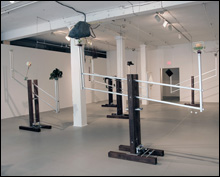
TIPPING POINT: The robotic machines are tremendously bigger and more captivating visually than the objects they set in motion.
|
By tipping point, they meant an event that was artistically transformative, particularly a health issue. One artist suffered migraines that escalated into epilepsy; he now mines the resultant disequilibrium for its creative potential. Another artist taps into the personal history of an eating disorder; a third was inspired to change the direction of a musical career after a finger injury. Like the way the show draws on suffering that’s been channeled into art, the narratives prove fascinating in their clinical reductions of lifetimes of pain. A statement from the show’s brochure: “Born with serious health issues, the informant from infancy through adulthood has undergone multiple corrective surgeries. . . . Her physical condition limits the size of the canvas she can work on.”
Unlike the narratives and no doubt the art that the seven “informants” produce, each of the tipping-point machines takes the same form. All measure in at the same oversized dimensions; all are identically constructed — cruciform scales that whir with the same sounds, ascend the same heights, and see-saw at the same point on the fulcrum. What changes are the objects at the far ends of the scales: an angled black box pitted against a gray plastic brain from which a tree branch extends; a boulder positioned above a dish of tapioca pudding (both fake) opposite which a sponge has been carved into the word “bitter”; a miniature keyboard that rises as a tangle of folding yard rules and a suspended pendulum falls. By not allowing the machines themselves to reflect the artists’ narratives, “Tipping Point” homogenizes the stories. The robotic machines are tremendously bigger and more captivating visually than the objects they set in motion. Maybe it should have been the other way around.
In the Mills Gallery Project Space, strangely iconic black-and-white photographs by Amber Davis Tourlentes document the corporatization of Boston’s Gay Pride Parade by depicting the handouts or swag that businesses have learned to distribute at the annual event. In each of her stark, square images we see an object or objects (wristbands, condoms, key chains, pens, balloons) that read alternately like zodiacal configurations and commercial messages — super-white objects printed with logos and sponsors’ names float in pitch black space. The disturbance is subtle and deep: what started as a protest to protect people’s lives has become a publicity opportunity.
ADVERTISEMENT
 |